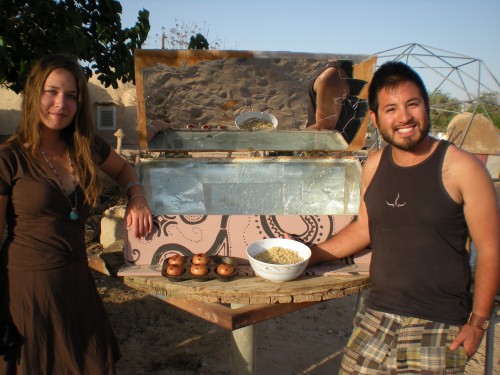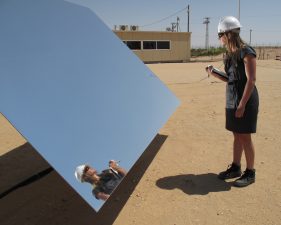In past Green Prophet articles, we’ve visted Kibbutzes in Israel’s Negev region — ones involved in environmental and renewable energy projects. Negev’s Arava- Arabah in Arabic – region north of Eilat) we take you on a journey visiting 5 of them.
While some of these are specializing in one type of project, like solar energy, others are involved in several projects, holistic ones including organic gardening and building ecological friendly homes. They are all must sees for the eco curious traveller and clean tech investor or business person.
1. Kibbutz Ketura: Located 50 km north of Eilat, Kibbutz Ketura owns 40% of Arava Power, one of Israel’s most promising solar energy companies.
Ketura, according to Wikipedia, is part of the so-called Green Kibbutz movement. It has pioneered many new ecologically sounder practices, as well as adopting more common environmentally friendly habits.
The Arava Institute for Environmental Studies, is also located here. The institute promotes regional cooperation between Israelis, Palestinians, and residents of other neighboring Arab countries in environmental matters. It also researches and draws attention to some of the ecological problems in the region, as well as researching the desert ecosystem.
The kibbutz owns Algatech, a company which produces algae and passes it through a filtration system to extract natural astaxanthin. The extract is then sold around the world as a natural high-quality ingredient for fish food; as a natural pigment for use in cosmetics, and as a nutraceutical.
2. Kibbutz Lotan: Also located in the Arava, and not far from Ketura, Kibbutz Lotan, which we’ve featured here for its solar powered Passover seder, is as close to a complete ecologically sustained environment as any community can get.
 Its Center for Creative Ecology has a number of ongoing projects including a special wetlands area that attracts thousands of migratory birds, and bird watchers, each year; organic gardening and alternative building projects, a Green Apprenticeship Program, and an “eco campus” that offers a special semester live-in Peace, Justice, and Environment program to give students a firsthand experience of working together for the sake of peace and the environment.
Its Center for Creative Ecology has a number of ongoing projects including a special wetlands area that attracts thousands of migratory birds, and bird watchers, each year; organic gardening and alternative building projects, a Green Apprenticeship Program, and an “eco campus” that offers a special semester live-in Peace, Justice, and Environment program to give students a firsthand experience of working together for the sake of peace and the environment.
Kibbutz Lotan ‘s has become well known for creating a totally sustainable environment in a most environmentally hostile part of Israel.
The Kibbutz also runs a unique desert vacation resort where guests can avail themselves to special holistic health treatments, special country lodging, outrageous desert tours, and educational eco-workshops.
3. Kibbutz Samar.This kibbutz was founded in 1976 by people from other kibbutzim who wanted to form a different kind of community. The name “Samar” comes from a plant that grows in the Arabah and near the Dead Sea.
It is one of the few kibbutzim that continues to maintain a lifestyle consistent with the original socialist ideals of the kibbutz movement, according to Wikipedia. Today about 50 to 100 families live there as of 2007.
Kibbutz Samar is primarily engaged in growing and exporting organic dates. Dates from Kibbutz Samar and other kibbutzim in the Ardom Co-op can be purchased in the United States at Mrs. Green’s Natural Market.
![aora-flower-solar-energy-500x372[1]](https://www.greenprophet.com/wp-content/uploads/2009/08/aora-flower-solar-energy-500x3721.jpg) Samar has also become involved in renewable energy projects, and recently, a special solar energy pilot plant became operational by the Aora Solar Energy company on June 24th.
Samar has also become involved in renewable energy projects, and recently, a special solar energy pilot plant became operational by the Aora Solar Energy company on June 24th.
The solar plant is one of most unusual designed ones to date, and involves a system of highly reflective mirrors called heliostats that move according to the position of the sun, heat is concentrated at 1000 degrees Celsius inside the “flower” part of the structure, elevated 30 meters above the ground. The tulip shaped flower has petals and contains a “solarized” micro gas turbine within; creating about 100 kw of electricity, which is enough for 70 homes.
4. Kibbutz Sde Boker: Situated south of Beer Sheva and on the northern edge of the Arava, Kibbutz Sde Boker (means Cowboy Fields) is the one where Israel’s first prime minister, David Ben Gurion, retired to with a call for young Israelis to “settle the Negev desert region”.
Although his philosophy never quite came to pass, Sde Boker became an open air “laboratory” and research center for a number of special environmental and scientific projects being carried out the his academic namesake, Ben Gurion University of the Negev (BGU), which operates a branch in Sde Boker.
For years, research has been carried out in Sde Boker dealing with solar energy and with finding ways to cope with the harsh desert environment of the Negev and Arava.
Building specially designed homes to withstand the frigid winter nights (using special insulation and unique designed windows to absorb sunlight during daytime hours) as well as the hot summer temperatures that often rise to more than 40 degrees Celsius (the special windows face away from the sun during the summer months).
Academic degrees dealing with environmental science and alternative and renewable energy technologies, are taught at BGU’s Sde Boker campus.
5. Kibbutz Yotvata: Like Sde Boker, Kibbutz Yotvata, was founded by young soldiers in the early 1950’s, and today has one of Israel’s must successful dairy farms and products plants, producing more than 63 million liters of milk per year and controlling more than 60% of Israel’s entire dairy products production.
(image via Ferrell’s travel blog)
Located in the southern Arava desert, Yotvata is close to other kibbutzim like Ketura, Lotan and Smadar, and receives milk from dairy herds in those kibbutzim for processing in Yotvata. The Kibbutz is well known for its chain of superb dairy restaurants which feature produce produced in the kibbutz, especially dairy products.
Yotvata’s most well known ecological achievement is its Hai Bar Nature Reserve, which covers 4,000 dunam (1,000 acres) and is home to a number of biblical animal species that have long become extinct in their native desert habitat.
Some of these animals include the onager or Asian brown ass , the Arabian oryx (a beautiful antelope species with majestically “twilled horns”), the Scimitar Horned Oryx (another large antelope species) and the African wild ass (what most modern Middle Eastern asses or donkeys are descended from). The African ostrich is being reintroduced, as well as a number of predators, including leopards, caracal wild cats, and desert foxes. Three striped hyenas are also in residence there.
More recently Yotveta also has a 40 kw “roof top” solar energy plant.
While each kibbutz is unique in itself, from an ecological and environmental standpoint, it’s easy to so that their combined efforts make the Arava desert region of Israel a very special place and well visiting and even living in.
Read more on Eco Travel:
UPDATE: In the first publication of this article Kibbutz Smadar was confused with Kibbutz Samar. The article has since been updated.



![fox-haibar-t[1]](http://greenprophet.com/wp-content/uploads/2009/08/fox-haibar-t1.jpg)



Sorry for the mix up between Kibbutz Neot Smadar and Smadar. It appears that the Aora solar plant was fired up at Samar, which also has the date grove.
Neot Smader is further north (near Ketura and Lotan) and is involved in a number of organic farming enterprises, including the 150 dunam olive grove and cold press olive oil plant.
Cheers,
Maurice
The story mentions that the solar field is not at the kibbutz. Thanks for reminding us about the Arava. It is important to note. I will update the story.
Continuing with Marc’s correction, Samar also has a 500-dunam organic date plantation.
To correct a few more inaccuracies — the nature preserve is not connected to Kibbutz Yotvata; it just shares its name. Yotvata has recently connected solar panels to the roofs of its cow sheds.
The field of solar panels in the picture has nothing to do with Kibbutz Ketura. On the other hand, Ketura should be noted for hosting the Arava Institute for Environmental Studies.
Thanks Marc. There was a confusion, I think, becomes the names are so similar. The article has been updated.
The picture of Neot Smadar and article has been mistakenly
related.It actually belongs to Kibbutz Samar.
Neot Smadar has an eco-air-cooling tower. check it too.